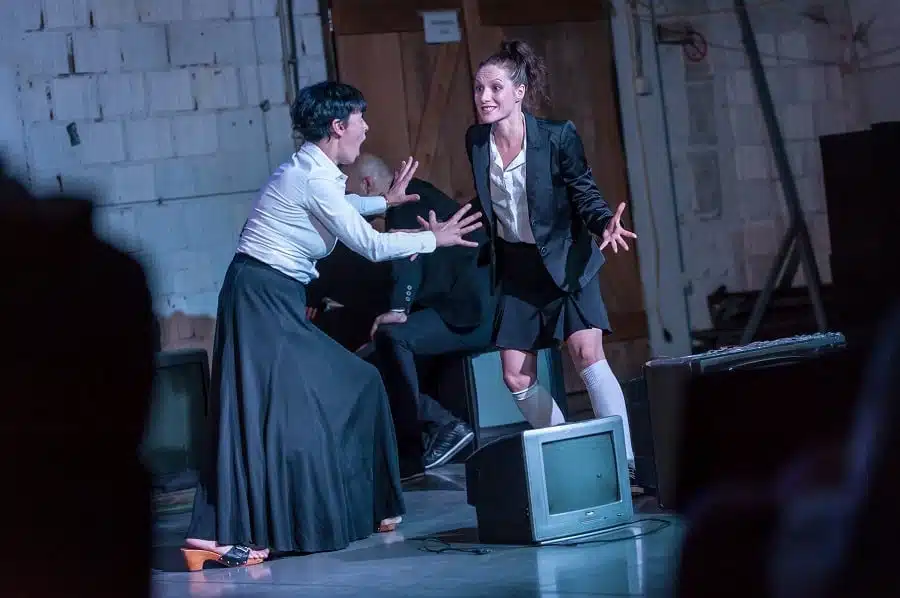Here are the differences between a monologue, soliloquy, and aside:
A monologue is a long uninterrupted speech that a character gives to another character.
A soliloquy is a long speech that a character gives to the audience to express their deepest thoughts and emotions.
An aside is directed at the audience too, but unlike a soliloquy, an aside is typically a quick comment.
If you want to know all about the differences between a monologue, soliloquy, and aside, then you’re in the right place.
Let’s dig right in!

What Are the Differences Between a Monologue, Soliloquy, and Aside?

| Monologue | Soliloquy | Aside | |
| Definition | An uninterrupted speech that’s spoken by only one character in a story or drama | A type of monologue that voices a character’s internal thoughts out loud | Is a short speech or remark given by a character to express his or her inner thoughts to the audience |
| How it’s expressed | When a single character speaks at (not conversing with) other characters | A single character speaks to himself (not to other characters) aloud | A single character speaks briefly to himself or herself as if commenting on oneself |
| Scope | Is it a speech given by only one character with other characters? | Is it a monologue not intended to be heard by other characters? | Is it a brief speech or remark spoken out loud to the audience by a single character? |
| Nature | Addressed to other characters on stage or on screen | A long speech addressed to oneself (or audience) | A short comment or a quick remark addressed to oneself (or audience) |
| Specificity | It’s intended to be heard by other characters in the story or drama | It’s not intended to be heard by other characters in the story | It’s not intended to be heard by other characters in the story |
Monologue, soliloquy, and aside are all speeches given by a single character, each for a different purpose and delivered in a different way.
Single-character speeches are a staple of theater, in particular, and variants of these techniques have been around as far back as Ancient Greece, in which the chorus often took on the earliest variants of the soliloquy and the aside.
In order to understand the importance of speeches in theater, we must first acknowledge the disadvantages of the medium that these speeches are meant to overcome.
Firstly, plays do not normally have a narrator to take on the duty of revealing information piece by piece to the audience.
Movies and novels can simply ask the narrator to reveal personal information that we would have no other way of knowing.

Still, the drama doesn’t usually have the luxury of an all-seeing, all-knowing figure that looms over the entire sequence of events.
As such, plays had to adapt by introducing techniques that could reveal the characters’ innermost thoughts.
This, essentially, is the issue that soliloquies and asides, meant to be given to the audience, are meant to address.
The other major shortcoming of theater as a medium is that you can generally only do so much with backgrounds and props.
We can’t expect every theater company to have the budget to flood the entire building when a scene needs to take place on board a sinking ship, for example.
The hilariously opulent Romans might disagree since they did basically do exactly that on occasion, but that’s a story for another day.
As such, monologues, in which the character can go on and on about settings or backstories that were previously invisible to the audience, can be an excellent way to insert the setting into an otherwise blank stage retroactively.
Of course, these techniques do have other unique traits and purposes of their own that are worth discussing, so let’s dive right in.
What Is a Monologue?

A monologue is a long uninterrupted speech that a character gives to another character.
It is important to identify that monologues are intentionally vocalized speech, whereas soliloquies tend to represent private thoughts in drama.
Monologues often reveal a character’s goals, schemes, or backstory to one or more other characters.
This is commonly used for a “big reveal” scene that explicitly breaks down secrets that have been kept from the audience from other characters, or from both.
Unlike soliloquies and asides, monologues are not necessarily restricted to the theater.
Movies, novels, video games, and other forms of media can all utilize a lengthy speech given by a particular character effectively.
One classic example is the infamous “villainous monologue” in which the antagonist of the story reveals their plans and backstory in excruciating detail, relishing in the shock of the protagonists who are seemingly helpless to derail their plans at that moment.
This moment is often the culmination of various formulaic tropes and has become a staple of good vs. evil narratives.
What Is a Soliloquy?

A soliloquy is a long speech that a character gives to express their deepest thoughts and emotions, particularly in theatrical settings.
The most famous soliloquies tend to be works of poetry rather than prose.
Shakespearian soliloquies, such as the iconic soliloquy in Hamlet, notably fit this criterion.
In that particular moment, when Hamlet gives his infamous “to be or not to be” speech, he is openly revealing details about his depressed state.
The phrase is really asking whether it’s better “to live or not to live” and goes on to emphasize the suffering brought about by life, questioning whether it might be better to simply drop dead instead, characterizing Hamlet’s morbidity.
Soliloquies were truly in their prime during the Elizabethan era in England, where many playwrights utilized poetic soliloquies with their characters.
Blank verse, a poetic form utilizing unrhymed iambic pentameter, was especially popular as a style of delivery.
Dramatists use soliloquies to simulate thought in a play.
Just as modern movies and video games utilize voiceovers to reveal the thoughts of the characters, plays have always needed ways to reveal the inner workings and emotional turmoil of the protagonists.
Soliloquy is mostly restricted to the theater since written works have the advantage of a narrator or speaker who can blatantly reveal the thoughts of the characters to the reader when necessary.
Playwrights may sometimes opt to utilize other characters as a stand-in for the audience, to ask probing questions, but soliloquy is one of the most revealing ways to explore a character’s thoughts on stage.
Ancient Greek plays utilized the chorus to achieve a similar effect, allowing the chorus to act as the play’s narrator, revealing the inner workings of the characters on stage.
One of the most defining features of a soliloquy is that it is intended to be a private moment that no other characters in the play can hear.
If there are other characters on stage, the audience is generally expected to understand that they are “not paying attention” to the soliloquy.
What Is an Aside?

An aside is similar to a soliloquy in many respects in that it’s directed at the audience of a play and is not meant to be heard by the other characters.
The major difference is in length.
Whereas a soliloquy is a lengthy speech, an aside is typically a quick comment.
Asides can be used to clarify something for the audience or to provide a sudden flash of insight into a character’s opinion or mental state.
As with soliloquies, asides rely on the audience’s suspension of disbelief to imply that no other character heard them.
Traditionally, asides are often used to break up the mood of a scene.
Due to their brevity, an aside can be an excellent way to inject sudden unexpected comedy into an otherwise serious scene.
The character might reveal something absurd or irreverent in the middle of an argument.
Alternatively, an aside can be used to inject a sense of human heart into a seemingly cold moment in the play.
Two characters may be arguing violently but revealing in asides to the audience that they wish they could shut their mouths and make up.
In this way, asides can be extremely similar in nature to the soliloquy in what they can reveal.
Movies and TV shows use similar pace-breaking techniques like cutaway gags and brief flashbacks for many of the same purposes.
